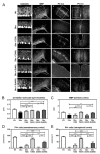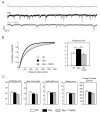Triac Treatment Prevents Neurodevelopmental and Locomotor Impairments in Thyroid Hormone Transporter Mct8/Oatp1c1 Deficient Mice
- PMID: 36834863
- PMCID: PMC9966820
- DOI: 10.3390/ijms24043452
Triac Treatment Prevents Neurodevelopmental and Locomotor Impairments in Thyroid Hormone Transporter Mct8/Oatp1c1 Deficient Mice
Abstract
Patients with inactive thyroid hormone (TH) transporter MCT8 display intellectual disability due to compromised central TH transport and action. As a therapeutic strategy, application of thyromimetic, MCT8-independent compounds Triac (3,5,3'-triiodothyroacetic acid), and Ditpa (3,5-diiodo-thyropropionic acid) was proposed. Here, we directly compared their thyromimetic potential in Mct8/Oatp1c1 double knock-out mice (Dko) modeling human MCT8 deficiency. Dko mice received either Triac (50 ng/g or 400 ng/g) or Ditpa (400 ng/g or 4000 ng/g) daily during the first three postnatal weeks. Saline-injected Wt and Dko mice served as controls. A second cohort of Dko mice received Triac (400 ng/g) daily between postnatal weeks 3 and 6. Thyromimetic effects were assessed at different postnatal stages by immunofluorescence, ISH, qPCR, electrophysiological recordings, and behavior tests. Triac treatment (400 ng/g) induced normalized myelination, cortical GABAergic interneuron differentiation, electrophysiological parameters, and locomotor performance only when administered during the first three postnatal weeks. Ditpa (4000 ng/g) application to Dko mice during the first three postnatal weeks resulted in normal myelination and cerebellar development but only mildly improved neuronal parameters and locomotor function. Together, Triac is highly-effective and more efficient than Ditpa in promoting CNS maturation and function in Dko mice yet needs to be initiated directly after birth for the most beneficial effects.
Keywords: Allan-Herndon-Dudley syndrome; Ditpa; SLC16A2; SLCO1C1; Triac; thyroid hormone analog; thyroid hormone transport.
Conflict of interest statement
The authors declare no conflict of interest.
Figures






References
-
- Friesema E.C., Grueters A., Biebermann H., Krude H., von Moers A., Reeser M., Barrett T.G., Mancilla E.E., Svensson J., Kester M.H., et al. Association between mutations in a thyroid hormone transporter and severe X-linked psychomotor retardation. Lancet. 2004;364:1435–1437. doi: 10.1016/S0140-6736(04)17226-7. - DOI - PubMed
-
- Groeneweg S., van Geest F.S., Abacı A., Alcantud A., Ambegaonkar G.P., Armour C.M., Bakhtiani P., Barca D., Bertini E.S., van Beynum I.M., et al. Disease characteristics of MCT8 deficiency: An international, retrospective, multicentre cohort study. Lancet Diabetes Endocrinol. 2020;8:594–605. doi: 10.1016/S2213-8587(20)30153-4. - DOI - PMC - PubMed
MeSH terms
Substances
Grants and funding
LinkOut - more resources
Full Text Sources
Molecular Biology Databases
Research Materials

